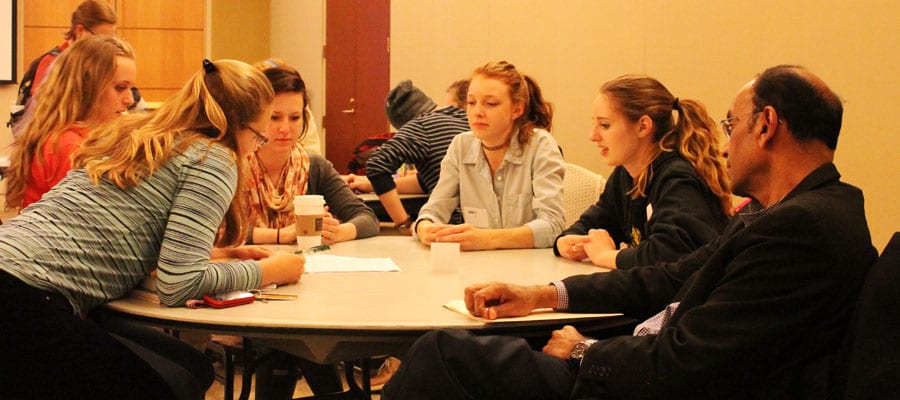
Students crowded into the Black and Gold Ballroom last Wednesday, April 16, to discover more about a new student organization stirring things up on campus. A group of ambitious Oles are working to found St. Olaf’s own branch of the Interfaith Coalition for Peace and Justice, and the event’s large turnout reflected their peers’ desire to engage in interfaith dialogue.
As the meeting began, students divided up into small groups and took a religious literacy quiz as a team. The questions asked students to identify specific beliefs or perspectives as grounded in various faiths. Most students did not make it to the end of the quiz before time ran out, and although many expressed surprise at how much they did know, they also found the quiz somewhat difficult.
The four leaders of the Interfaith Coalition for Peace and Justice – Kiki Sykes ’16, Nora Uhrich ’16, Leah Plasek ’16 and Kully Vance ’16 – then went to the front of the room and began to explain the mission of the group and the vision for its presence on campus. They explained that religion can be a bomb, a barrier or a bridge, and that through constructive discourse about the faiths of the world they hope to make religion a bridge on the St. Olaf campus. Through discussions, fellowship opportunities and service projects, they hope to increase religious tolerance and appreciation.
Bringing a scholarly perspective to the table, Professor of Religion Anantanand Rambachan spoke about the public value of religious dialogue. He explained that the world has always been religiously diverse, and therefore he doubts that human beings will ever be brought under the umbrella of a single religious tradition. In fact, he reported that the world is experiencing a resurgence of religious identity.
Professor Rambachan warned of the dangers of closed-mindedness. “News reports make us aware of the fear and hatred surrounding religious identity, but we must remember that all of our traditions have been objects of hate,” Rambachan said. Religion is not only a theological concern, but it is also a political concern because strong beliefs have the power to influence policy-making.
The U.S. is home to hundreds of religions. Rambachan explained that ever since President John F. Kennedy opened the doors to Asia by abolishing immigration quotas in 1965, the religious landscape of the country has greatly changed. Today, places of worship and meditation for most religions can be found in all major cities in the country.
Although religious diversity has increased, religious literacy has notquite kept pace. A 2010 study by the PEW Research Center reported that U.S. residents achieved an average score of 50 percent on the religious literacy quiz. Rambachan explained that it is essential that St. Olaf students begin discussions now that will increase religious literacy in the future.
“Dialogue is not an ambulance service; it is a public health program, and it requires long-term investment,” Rambachan said.
Rambachan explained that any religious tradition that has a vision for a community is called upon to reach across religious frontiers, and that religious literacy, if it is to lead to peace and justice, cannot be realized by one religion on its own.
“Our mission for peaceful and just communities will be realized together or not at all,” Rambachan said.
After such a well-attended first event, it is difficult to imagine that three months ago the Interfaith Coalition for Peace and Justice was only an idea. Over Interim, Sykes attended the Montreat College Conference in North Carolina, which focused on the idea of interfaith dialogue.
“I came back to campus for Interim, and during that first week back I couldn’t ignore this deep tug, urging me to start an interfaith group here on campus,” Sykes said. “So I gathered a few interested friends, and one Friday night we all sat around and envisioned together what an interfaith group would look like on campus. Then all of a sudden we were drafting the mission statement.”
Coalition leaders were ecstatic about the event turnout. “We hope to expand the group as time goes on and gain some more diverse faith/non-faith representation, but I think we’re off to a strong start,” Plasek said. “It was so exciting to see all the interest and enthusiasm for interfaith cooperation that we have on campus.”
Sykes explained that her greatest challenge in starting the group was not knowing how interested Oles would be. “The hardest thing has been trying to create a group for an unknown audience,” she said. “We planned this kickoff event and truly had no earthly idea who would show up, how many people would come, what they would think about it, and on and on. We have been working with a squeaky clean white board here, which is really sort of wonderful.”
The St. Olaf community appeared open and receptive to the mission of the Interfaith Coalition for Peace and Justice. “It seems like we talk about diversity a lot here at St. Olaf, and it’s a value a lot of people embrace, but the actual practice of it is more difficult, and I think that intentional efforts need to be made in order to succeed in that,” Uhrich said.
The group hopes to create intentional opportunities to foster these conversations that will lead to understanding, tolerance and a change in social attitudes.
mihelich@stolaf.edu
Photo Credit: BEKAH ENGSTRAND/MANITOU MESSENGER

